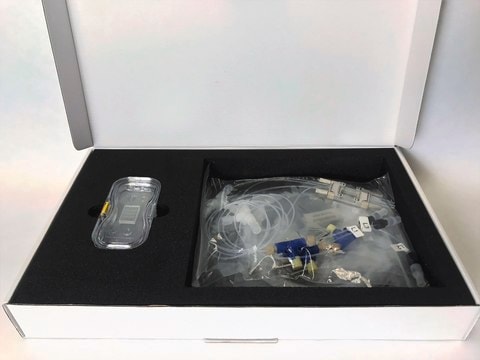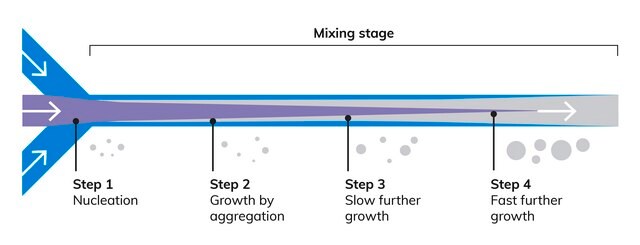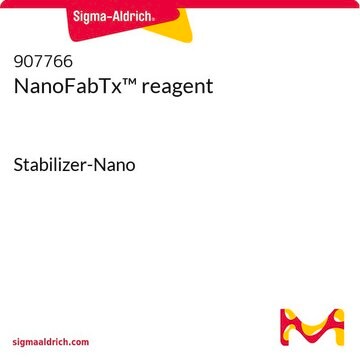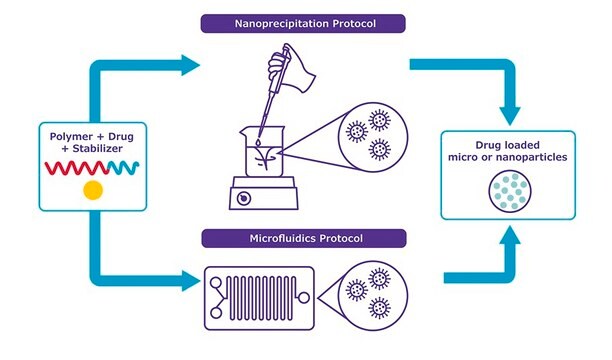推薦產品
一般說明
The NanoFabTx™ Polymer drug formulation kit, PLA, for synthesis of 100 and 200 nm particles is a ready-to-use nanoformulation kit for the synthesis of drug-encapsulating PLA-based nanoparticles. This kit provides properly selected PLA based polymers, stabilizer, and protocols for fabrication of PLA nanoparticles by both nanoprecipitation and microfluidic-based synthesis. The microfluidics protocol uses a NanoFabTx™ device kits (911593, sold separately), which provide all the microfluidics chips, fittings, and tubing required to get started with microfluidics-based synthesis (compatible microfluidics system or syringe pump required).Comprehensive protocols for two different particle synthesis methods are included:
- A nanoprecipitation protocol to prepare drug-encapsulated nanoparticles in standard laboratory glassware.
- A microfluidics protocol using commercial platforms or syringe pumps.
應用
The NanoFabTx™ Polymer drug formulation kit, PLA, for synthesis of 100 and 200 nm particles enables users to encapsulate a wide variety of therapeutic drug molecules in PLA-based nanoparticles. Drug encapsulated nanoparticles synthesized with the NanoFabTx™ kits are suitable for biomedical research applications such as oncology, immuno-oncology, gene delivery, antigen delivery, and vaccine delivery. Poly(D,L-lactic acid) (PLA) is a biocompatible and biodegradable polymer that has been approved by the FDA for biomedical and pharmaceutical applications. Because of their robust mechanical properties and slow degradation, PLA based nanoparticles have been widely used as drug delivery systems to achieve controlled drug release for different types of therapeutic molecules. This kit minimizes laboratory setup with optimized protocols and step-by-step instruction for synthesizing drug-encapsulated nanoparticle-based formulations. It is designed to help pharmaceutical researches achieve reproducible synthesis with high loading efficiencies without the need for lengthy trial-and-error optimization.
特點和優勢
- Ready-to-use nanoformulation kit for PLA nanoparticles
- Step-by-step protocols developed and tested by our formulation scientists
- Flexible synthesis tool to create uniform and reproducible nanoparticles
- Optimized to make nanoparticles 100–200 nm nanoprecipitation or microfluidics with low polydispersity
- Based on non-toxic, biodegradable polymers
法律資訊
NANOFABTX is a trademark of Sigma-Aldrich Co. LLC
相關產品
產品號碼
描述
訂價
儲存類別代碼
11 - Combustible Solids
S Freiberg et al.
International journal of pharmaceutics, 282(1-2), 1-18 (2004-09-01)
Polymer microspheres can be employed to deliver medication in a rate-controlled and sometimes targeted manner. Medication is released from a microsphere by drug leaching from the polymer or by degradation of the polymer matrix. Since the rate of drug release
Verónica Lassalle et al.
Macromolecular bioscience, 7(6), 767-783 (2007-06-02)
The controlled release of medicaments remains the most convenient way of drug delivery. Therefore, a wide variety of reports can be found in the open literature dealing with drug delivery systems. In particular, the use of nano- and microparticles devices
Nazila Kamaly et al.
Chemical Society reviews, 41(7), 2971-3010 (2012-03-06)
Polymeric materials have been used in a range of pharmaceutical and biotechnology products for more than 40 years. These materials have evolved from their earlier use as biodegradable products such as resorbable sutures, orthopaedic implants, macroscale and microscale drug delivery
Byung Kook Lee et al.
Advanced drug delivery reviews, 107, 176-191 (2016-06-06)
Poly(d,l-lactic acid) (PLA) has been widely used for various biomedical applications for its biodegradable, biocompatible, and nontoxic properties. Various methods, such as emulsion, salting out, and precipitation, have been used to make better PLA micro- and nano-particle formulations. They are
文章
Professor Robert K. Prud’homme introduces flash nanoprecipitation (FNP) for nanoparticle fabrication, which is a scalable, rapid mixing process for nanoparticle formulations.
我們的科學家團隊在所有研究領域都有豐富的經驗,包括生命科學、材料科學、化學合成、色譜、分析等.
聯絡技術服務





